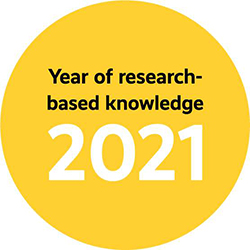AI sees students as snowflakes
14.12.2021More and more studies can be completed online. The need for additional online content requires better support from online learning environments. Can AI be harnessed to support learning in the online environment?
 The popularity of e-learning that is independent of time and place is on the rise. However, the digitalization of learning situations and environments creates new types of pedagogical challenges, as the classroom interaction does not transfer over to digital communication channels. New learning environments and situations require ways to activate students, for example utilizing new technologies.
The popularity of e-learning that is independent of time and place is on the rise. However, the digitalization of learning situations and environments creates new types of pedagogical challenges, as the classroom interaction does not transfer over to digital communication channels. New learning environments and situations require ways to activate students, for example utilizing new technologies.
Gamification is often proposed as the solution to better engage and motivate students online. Gamification is the use of game elements in nongame environments. Examples of gamification include competitions, challenges, and point systems. Gamification has been found to have a positive effect on a student’s motivation and gamified learning challenges can improve the learning experience.
However, the design of gamified elements can be challenging because each student has their own, individual preferences. The challenges should be tailored to each student’s liking: Like snowflakes, all students are unique.
From personal preferences to individual challenges
Using machine learning methods such as clustering or neural networks, students’ preferences can be categorized and analyzed. With artificial intelligence, it is possible to monitor the students’ progress in an online environment, and analyze their preferences based on their activity. These preferences can then be used to create tailored learning activities for each student.
Using this approach, we trained an artificial intelligence algorithm to identify students’ preferences on an e-learning platform. After observing the students’ online activities for some time, the AI algorithm started to create individual challenges based on gamification design models. The algorithm was able to create individually tailored learning challenges: For example, a social person received interaction-related tasks, while a performance-focused person was tasked with scoring-related activities.
In an online classroom, artificial intelligence can adapt the different learning materials and tasks to suit each student. The principles of gamification are then used to provide students with the right challenges to support learning. This improves study motivation, encourages teamwork online, and creates tailor-made tasks for each learning situation.
References
Hynninen, T., Knutas, A., Hajikhani, A., & Kasurinen, J. (2017). Learning System User Interface Preferences: An Exploratory Survey. In Proceedings of the Doctoral Consortium, Posters and Demos at CHItaly 2017 (pp. 124–128).
Knutas, A., van Roy, R., Hynninen, T., Granato, M., Kasurinen, J., & Ikonen, J. (2017). Profile-Based Algorithm for Personalized Gamification in Computer-Supported Collaborative Learning Environments. In Proceedings of the 1st Workshop on Games-Human Interaction (GHITALY 2017).
Knutas, A., van Roy, R., Hynninen, T., Granato, M., Kasurinen, J., & Ikonen, J. (2018). A process for designing algorithm-based personalized gamification. Multimedia Tools and Applications, 1–20.
This article appeared originally in Finnish (https://read.xamk.fi/2019/digitaalinen-talous/tekoaly-nakee-opiskelijat-lumihiutaleina/).
The article is based on scientific publications by the author. The work was partially funded by the European Union Regional Development Fund grant number A70554, ”Kyberturvallisuusosaamisen ja liiketoiminnan kehittäminen” administrated by the Council of Kymenlaakso.





































